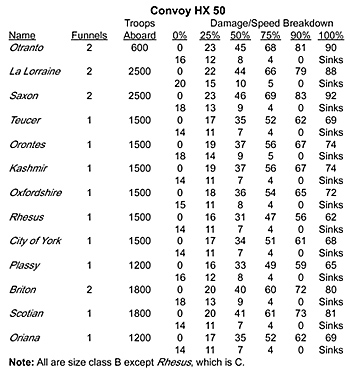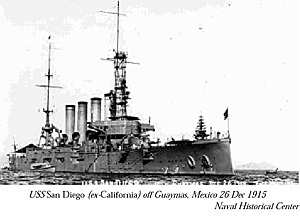Scenario: Convoy HX 50
Location: 1200 nm east of Halifax, 30 September 1918, 0136 hours local time.
Operational Situation: Large numbersof US troops were flowing to France, adding to the pressure against Germany on the Western Front. In a desperate measure to stem this tide, the High Seas Fleet sent surface forces into the Atlantic, slipping past the North Sea Mine Barrage and the Northern Patrol in an attempt to disrupt the troop convoys from America. They spotted convoy HX 50, carrying over 20,000 US troops.
Tactical Situation: This fictional scenario has four different German options for play. The Allied setup is historic. The Germans choose their force from the options, and then set up with the German unit(s) at the limit of visual range. (If the German player selects the U-boat, it will start on the surface; he may choose to attempt to maneuver ahead of the convoy and dive into an ambush position, in which case the game may switch to operational turns. If using operational turns, the Allied player may choose to employ a zig-zag at each operational turn, but may not select a westerly course at any time, i.e., between 181° T and 359° T, and must have gained at least 30 nm towards the east by 0600, or he suffers at least a tactical defeat regardless of other victory conditions.) The weather has cleared off and Louisiana has just rejoined the convoy, after being separated from it for 60 hours due to fog!
Environment: Night, Clear; visibility 3 nm; a 20% of full moon has just risen above the horizon bearing 071° T. Roll for cloud layers and sea state (reject overcast and any sea state above 5, and re-roll). If cloud layers exist, roll D6 every 9/6/3 tactical turns depending on whether clouds are scattered/ intermittent/broken. On a roll of 4-6 the moon is behind clouds for 1/2/3 tactical turns, depending on cloud layers. If the moon is behind clouds, visibility drops to 1 nm during those Tactical Turns.
Allied Forces
Louisiana (Connecticut-class BB)
St. Louis (St. Louis-class CR)
Dorsey (Wickes-class DD)
British AMC Otranto (also carrying 600 US soldiers)
 Allied Convoy: The table lists the ships in convoy, the number of funnels (to aid in choosing miniatures or counters), the number of US troops aboard, and their damage point/speed breakdown data. Other than Otranto, which is listed for convenience, all these ships are all AP
(transport) types, and all are size class B except Rhesus, which is C.
Allied Convoy: The table lists the ships in convoy, the number of funnels (to aid in choosing miniatures or counters), the number of US troops aboard, and their damage point/speed breakdown data. Other than Otranto, which is listed for convenience, all these ships are all AP
(transport) types, and all are size class B except Rhesus, which is C.
Note that Otranto's Damage/Speed lines are incorrect in Annex A as printed. The values in the table are correct. The British ships other than Otranto have an estimated armament of P/S(1)2 6"/40 QF MkI, and P/S/A(1)3 4"/40 QF. All are local control only. The French AP La Lorraine has an armament of P/S(1)4 M1891 138mm/45, local control only..
Allied Orders: Engage and drive off enemy vessels attempting to attack the convoy. If engaged by superior forces, disperse the convoy and delay the enemy so that the convoy can escape.
Allied Victory Conditions
Decisive: No ship in the convoy damaged, and German ships’ speed reduced below convoy speed.
Tactical: No transports lost and raiders destroyed or driven off.
German Forces
A) Light cruisers Dresden and Cöln (Cöln class)
B) Battlecruisers Moltke (Moltke class) and Seydlitz (Seydlitz class)
C) Battlecruisers Derfflinger (Derfflinger class) and Hindenburg (Hindenburg class)
D) U-140 (U-139-class submarine)
German Orders: Break through the enemy escort and attack the convoy. Avoid decisive engagement with superior forces.
German Victory Conditions:
Decisive: Three or more transports sunk and the raider(s) escape with less than 10%
damage.
Tactical: One transport sunk and the raider(s) escape with less than 5% damage.
Otranto counts as a transport for the victory conditions.
Setup
The scenario takes place in open ocean. The convoy is steaming on course 085° at 13 knots in four columns, with the right center column led by Otranto, which is also the convoy flagship; and the left center column by Kashmir. The remaining APs may be placed in any other column position in any order desired by Allied players. USS Dorsey should be ahead of convoy by no more than 4 miles. The other escorts can be placed up to 3 nm from the nearest convoy ship.
The German force is then set up as desired at the limit of visibility from the nearest ship.
Historical Outcome
The convoy was not intercepted because the German vessels did not break out, nor did it suffer submarine attack. However, after the US escorts left and two British M class destroyers arrived, west of Ireland, the convoy entered more heavy fog, became disorganized, sailed through a flotilla of unlighted fishing vessels, where Otranto rammed a French barkentine. She picked up survivors, sank the drifting wreck with her guns, and hurried to rejoin the convoy.
With the convoy emerging from the fog into heavy seas, land was sighted and misidentified (as different places) by Otranto and Kashmir, who turned towards each other and collided. Otranto fought her damage for a while, but then lost her engines, and in one of those daring pieces of seamanship one occasionally reads about, HMS Mounsey took off a large number of personnel by letting wind and wave push the destroyer alongside the damaged former liner. Several hundred men leaped from the high decks of the Otranto down to the destroyer; some were lost and others injured, but many got aboard safely.
Finally, the destroyer could accommodate no more and the Otranto smashed into the reefs and cliffs of the Isle of Islay. Sixteen of those still aboard survived a swim to shore, but in the end eighty of her crew and 351 US soldiers aboard died. Kashmir had suffered 20 deaths aboard from the influenza outbreak; the losses on other ships are not available.
Special rules
1) Otranto is the convoy commo-dore and overall flagship. Louisiana is senior ship of the US force and effective US flag ship if Otranto directs the US escorts to maneuver as a separate unit. Note that Otranto ‘s Damage/Speed lines are incorrect in Annex A as printed. The values in the table are correct.
2) Louisiana was equipped with both the Ford Rangekeeper and the British Pollen Argo system, for comparative trials. Louisiana should receive the shooting benefit of the Argo/Ford systems (Rules section 6.1.2) and is considered to have a secondary battery director. Louisiana has not yet had all her 7 inch removed - she still has four of these guns aboard.
3) All the US ships were suffering from poor training, due to rapid expansion of the US Navy and crew inexperience. All US ships (including the Louisiana!) will have an automatic -15% (before halving) modifier included with any other shooting modifiers!
4) Just to make things even worse, the Spanish Influenza epidemic struck this convoy while at sea! For each Allied escort, including the Otranto, roll D6 and subtract 2 - that number of weapon mounts, chosen randomly, is out of action because the crews are too sick to fight them! Louisiana’s 12 inch turrets are exempt from this; choose any secondary mount instead. Note that gun crews can be ordered to change mounts if they are nominally on the unengaged side; it will take one Tactical Turn to shift crews.
5) British intelligence handbooks of 1917-1918 assert that in night actions, German capital ships did not fire the turret immediately forward of the bridge to avoid ruining the night-vision of the bridge crews. If using German force B or C, impose that limitation.
 USS San Diego (ex-California) off Guaymas, Mexico 26 Dec 1915 (Naval Historical Center)
USS San Diego (ex-California) off Guaymas, Mexico 26 Dec 1915 (Naval Historical Center)
Variants
1) Approximate troop loads are provided for the transports in case the optional search and rescue rules are used.
2) For comparison, the liner Leviathan sailed 4 days later with a single Wickes-class destroyer as escort, and the day after her, 31 cargo ships, a mix of US, British, Italian, Japanese, and Portuguese vessels escorted only by the Des Moines. Either of these convoys, taken as typical, could be the basis of a similar scenario. The German battlecruisers would probably avoid a non-troop convoy, however.
3) The US stationed three battleships at Berehaven, Ireland to respond to the threat of German battlecruisers raiding North Atlantic Troop convoys. Give the Allies this force, which starts the scenario 30 + 2D6 nm due east of Otranto. The Spanish influenza epidemic has not yet reached this force, so they are exempt from special rule 4.
Nevada, Oklahoma (Nevada-class BBs) and Utah (Flag) (Florida-class BB)
All three battleships have a kite balloon (Rules section 5.9).
Destroyers: Class:
Conyngham Tucker
Terry Paulding
Stevens Wickes
Downs Cassin
Sampson Sampson
Allen Sampson
Beale Monaghan
The US battleships have Ford Rangekeepers but are insufficiently trained; like Louisiana, they get the bonus of superior FC gear but the negative impact of insufficient gunnery training. They have received directors for their secondary (5 inch) batteries. The US destroyers do not suffer the training penalties. (This force actually sailed two weeks later when intelligence reports of a German battlecruiser squadron reached the US and British commands. They met convoy HX 51 and escorted it into Irish waters. Two of the three battleships had lost their kite balloons to thunderstorms.)
Books
History of the Naval Overseas Transportation Service in World War One, by Lewis P Clephane, Division of Naval History, 1969. This obscure and valuable book has a complete list of merchants administered by the USN during WW I, as well as providing the discussion of convoys and escorts and the North Atlantic Cruiser Force.
U.S. Battleship Operations in World War I, Jerry W. Jones, Naval Institute Press, 1998.
http://raven.cc.ukans.edu/~libsite/wwi-www/Hurley/bridgeTC.htm This link is the complete text of The Bridge to France by the wartime Chairman of the American Shipping Board.
More WWI North Atlantic Cruiser Force
BT
Back to The Naval Sitrep #21 Table of Contents
Back to Naval Sitrep List of Issues
Back to MagWeb Master Magazine List
© Copyright 2001 by Larry Bond and Clash of Arms.
This article appears in MagWeb (Magazine Web) on the Internet World Wide Web.
Other military history and related articles are available at http://www.magweb.com